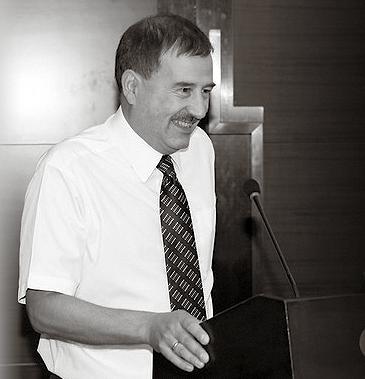
5 minute read
Careers: best-laid plans
At the end of September 2019, I retired as Head of Bacteriology at the National Institute for Biological Standards and Control (NIBSC) after 10 years as part of the senior management team. The aim was to seek new challenges and restore a sensible work–life balance by eliminating management responsibilities, leaving more time to think about science. Little did I know how dramatically plans would have changed by the start of 2020.

Advertisement
I began studying bacteriology at the University of Newcastle upon Tyne (Newcastle University) in 1976, where Max Sussman (former SfAM President) would be my undergraduate tutor for the next three years. It was an interesting time to embark on a career in microbiology, given recent developments in genetic engineering. By the late 1970s, nucleotide sequencing methods had also been published and were increasingly being used to characterise bacterial genes. Together with the recent discovery of transposable elements in bacteria, these developments provided a new toolkit for studying bacterial genetics. I remained in Newcastle using many of these molecular tools in my PhD research on the virulence factors of uropathogenic Escherichia coli, which was funded by a Luccock scholarship from the university. The project was co-supervised by Steve Parry and Colin Harwood (former editor of Letters in Applied Microbiology (LAM). I am indebted to Colin in particular for his continued support and friendship throughout my career.
Ian Feavers
Meetings Secretary, SfAM In 1982, I moved to the University of Sheffield as a postdoctoral research assistant with Anne Moir, using funding released by her recent appointment as a lecturer in microbiology. Anne had recently cloned the gerA locus from Bacillus subtilis in a bacteriophage λ vector; our task was to characterise the genes and their expression. With PCR yet to be developed, this largely involved subcloning, transposon mutagenesis and nucleotide sequencing. GerA was the first germination receptor to be sequenced and became the model for other germination receptors in the Bacillus genus. The product of a tricistronic operon, it is developmentally regulated as a member of the sigma G regulon along with other genes expressed only in the forespore compartment of sporulating cells. During my time in Sheffield, I attended my first international conference in Asilomar, California, which was followed by a ‘mini-sabbatical’, allowing me time to work with collaborators at UC Davis and UC Berkeley, as well as explore Yosemite and the Sierra Wilderness.
After four years in Sheffield, it was time to broaden my experience and in 1986 I took a postdoctoral fellowship at the Friedrich Miescher Institute (FMI) in Basel, which was developing innovative ways to study the
regulation of eukaryotic genes by hormones. Here, I gained confidence in developing new molecular approaches from scratch and experience of exploring protein–nucleic acid interactions. Our first daughter was born in June 1988 and, while postdoctoral research work on short contracts had been great fun, it was clearly time to find a longer-term role. Deciding I was at heart a microbiologist, the following January I started a five-year tenure-track group leader post in the Division of Bacteriology at NIBSC.
NIBSC principally exists to ensure that vaccines and blood products meet quality specifications, and to provide the standards used to calibrate bioassays. These activities are underpinned by applied research. It had recently moved to new purpose-built laboratories with a substantial budget for new equipment, making it an attractive next step. Fortuitously, Martin Maiden had joined NIBSC a few months earlier and, with our shared interest in applying molecular methods to bacterial problems, we pooled resources to collaborate in research. This was the start of a great friendship and fruitful collaboration that was to last to this day.
We started by applying the latest sequencing methods to investigate the antigenic variation of meningococcal outer membrane proteins because of their importance in vaccine development and typing isolates. The need to put our observations in the wider context of the meningococcal genotypes found in disease and asymptomatic carriage led us to develop multilocus sequencing typing (MLST). Based on this initial development in the meningococcus, today there are MLST schemes for more than 100 microbial species. Our research output enabled us both to fulfil tenure-track requirements, becoming permanent members of staff and senior scientists at NIBSC. In 1997, Martin moved to the University of Oxford as a Wellcome Trust Senior Research Fellow, becoming Professor of Molecular Epidemiology in 2004. We continued to collaborate productively over the ensuing years and continue to publish together to this day. I remained at NIBSC, as a principal scientist, managing the team responsible for meningococcal and pneumococcal vaccines, which were approved and rolled out from the end of the decade. Because of NIBSC’s close relationship with the World Health Organization (WHO), I was seconded to their Geneva headquarters for a few months in the late 1990s to help draft regulatory guidance on these vaccines. In addition, I have participated in a number of WHO missions and training workshops around the world and the team provided regulatory guidance to the WHO/PATH Meningitis Vaccine Project, whose aim was to eliminate meningitis in sub-Saharan Africa. During this time, I was on the editorial board of the Journal of Applied Microbiology (JAM), for a while as a co-editor, and served my first term on the Executive Committee (EC) of SfAM.
In 2009, I became Head of Bacteriology and hence a member of senior management. I continued to engage with meningococcal research, thanks to my excellent colleagues in the meningitis team; however, successive rounds of organisational change, increasing bureaucracy and then, after the 2016 referendum, work to mitigate the impact of Brexit, eventually left little time to participate in science. After 10 years in the role, I decided to take my pension and get back to science. Currently, I have an emeritus senior research associate position in the Maiden Group in Oxford and continue to work with WHO as a member of its Expert Committee on Biological Standardisation. The latter has been far busier than anticipated due to the urgent demand for written and physical standards to support developments in the diagnosis, prophylaxis and treatment of COVID-19. I am approaching the end of my second term on the EC of SfAM as Scientific Programmes Secretary but look forward to being part of the SfAMily long into retirement.










